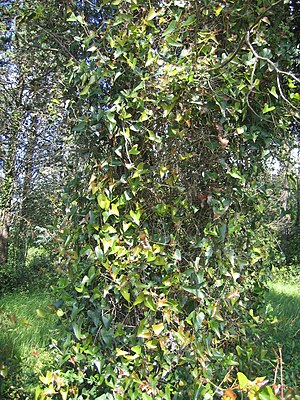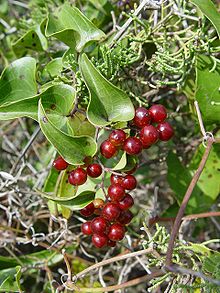Rough bindweed
| Rough bindweed | ||||||||||||
|---|---|---|---|---|---|---|---|---|---|---|---|---|

Rough bindweed ( Smilax aspera ) |
||||||||||||
| Systematics | ||||||||||||
|
||||||||||||
| Scientific name | ||||||||||||
| Smilax aspera | ||||||||||||
| L. |
The rough winds ( Smilax aspera ) is a species of the genus winds ( Smilax ) within the family of the winds ( Smilacaceae ). It thrives in the Mediterranean , Africa and Asia.
description
Vegetative characteristics
The Raue Stechwinde is an evergreen , woody climbing plant that climbs up to 15 meters. The branches are clearly square, bent back and forth and more or less densely covered with slightly curved, short and slightly compressed spines .
The alternate leaves are arranged in a petiole and a leaf blade. The petiole is often curved or twisted, 3 to 4 inches long and sometimes occupied with a few spines. Two long tendrils grow at the base of the petiole . The simple, striking, glossy, heart-shaped to spear-shaped leaf blade is coarse, leathery, heart-shaped-triangular to ovoid-lanceolate, 6 to 15 centimeters long and 5 to 9.5 centimeters wide. The base of the blades is heart-shaped or broad-wedge-shaped. The leaf margin and the central rib of the leaf underside are often provided with spines. Both sides of the leaf are glossy green, the upper side is often spotted or marbled white. Four to nine leaf veins can be seen per leaf blade .
Generative characteristics
The Raue Stechwinde is dioecious, separate sexes ( diocesan ). Of from 5 to 25 seated, three to sechsblütigen doldigen part inflorescences composite, spiked whole inflorescence is 7 to 45 centimeters long with an extended axis and slightly thickened base. Numerous broadly egg-shaped pre-leaves are formed.
The flowers smell strong and pleasant. The unisexual flowers are threefold. The perianth is simple and not divided into calyx and crown. The bracts of the male flowers are white, 4 to 5 millimeters long and about 1 millimeter wide. Their stamens are 2 to 2.5 millimeters long. Female flowers have somewhat smaller bracts and six staminodes .
The berries are initially green, red during ripening and later turning blue-black, with a diameter of up to 5 millimeters. The dark brown seeds are 4 millimeters long.
Chromosome set
The basic chromosome number is x = 16; there is diploidy with a chromosome number of 2n = 32.
distribution
The distribution area of the rough winds stretches from the Mediterranean to Malawi in Africa and to India, Nepal and Sri Lanka in Asia. It thrives in maquis , forests and on walls. In China, they can be found in forests at altitudes of 1000 to 2000 meters in southwest Yunnan and in the south of the Tibet Autonomous Region .
Systematics
The first publication of Smilax aspera took place in 1753 by Carl von Linné in his work Species Plantarum , 2, pages 1028-1029. Synonyms for Smilax aspera L. are: Smilax aspericaulis Wall. ex A.DC. , Smilax maculata Roxb. Smilax sagittata Desv. ex Ham.
The species Smilax aspera belongs to the genus Smilax within the family of the Smilacaceae .
From Smilax aspera several varieties or subspecies have been described, their status is unclear. The subspecies Smilax aspera subsp. mauritanica ( Poir. ) Arc. has broad, heart-shaped leaves and is almost thornless.
Use and ingredients
The young shoots are eaten as a vegetable , similar to wild asparagus . The roots and shoots contain heterosides , parillin and potassium nitrate . They were used medicinally as a diuretic and as a substitute for Smilax Regelis .
proof
literature
- Ingrid Schönfelder, Peter Schönfelder: The cosmos Mediterranean flora. Over 500 Mediterranean plants in color photos (= Kosmos nature guide ). 3. Edition. Franckh-Kosmos, Stuttgart 1999, ISBN 3-440-07803-5 , pp. 268, 269 .
- Andreas Roloff, Andreas Bärtels: Flora of the woods. Purpose, properties and use . 3rd, corrected edition. Eugen Ulmer, Stuttgart (Hohenheim) 2008, ISBN 978-3-8001-5614-6 , pp. 603 .
- Chen Xinqi, Tetsuo Koyama: Smilax. In: Wu Zheng-yi, Peter H. Raven (Ed.): Flora of China. Volume 24: Flagellariaceae through Marantaceae. Science Press and Missouri Botanical Garden Press, Beijing and St. Louis, 2000, ISBN 0-915279-83-5 . Smilax aspera , p. 115 - online with the same text as the printed work.
Individual evidence
- ↑ Roloff et al .: Flora of the Woods , p. 603
- ↑ a b c d Chen Xinqi, Tetsuo Koyama: Smilax. In: Wu Zheng-yi, Peter H. Raven (Ed.): Flora of China. Volume 24: Flagellariaceae through Marantaceae. Science Press and Missouri Botanical Garden Press, Beijing and St. Louis, 2000, ISBN 0-915279-83-5 . Smilax aspera , p. 115 - online with the same text as the printed work.
- ↑ a b c d e Schönfelder et al .: Die Kosmos-Mediterranflora , p. 268
- ↑ a b Smilax aspera at Tropicos.org. In: Flora of Pakistan . Missouri Botanical Garden, St. Louis
- ↑ Smilax aspera at Tropicos.org. In: IPCN Chromosome Reports . Missouri Botanical Garden, St. Louis
- ↑ Smilax aspera in the Germplasm Resources Information Network (GRIN), USDA , ARS , National Genetic Resources Program. National Germplasm Resources Laboratory, Beltsville, Maryland. Retrieved August 24, 2010.
- ↑ a b c Smilax aspera at Tropicos.org. Missouri Botanical Garden, St. Louis, accessed October 13, 2013.
Web links
- Smilax aspera at Plants For A Future . Retrieved August 24, 2010.




